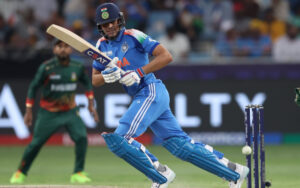
Bharath Ramaraj in Dubai
Shubman Gill cracked nine fours and two sixes during his superlative innings of 101 against Bangladesh in a Champions Trophy game in Dubai. Those 11 hits included a sumptuous whip, a flick played with a straight bat, and a short-arm jab cracked with nonchalance. In a nutshell, Gill put on an exhibition of sublime timing and how to keep the head still while essaying a stroke. Yet, the highlight of his batting wasn’t anything to do with his array of shots. It was more to do with how well he changed gears as per different situations of the game and steered India through a tricky chase.
Pinching singles was one of the nuts and bolts of Gill’s batting manual. Just to add credence to the theory, scroll through how Gill went about building his innings after Rohit Sharma’s dismissal. Gill, who was then scoring at a strike-rate of more than 100, decided to knuckle down and looked to deal in a diet of singles and twos.
Even when Virat Kohli was struggling a touch to farm the strike, Gill wasn’t tempted to go for the big shot. During his 43-run alliance with Kohli, Gill managed to collect 15 singles, one double and a four. It says something about how Gill was able to envision the big picture of guiding his side past the finish line. He continued in the same vein after both Axar Patel and Shreyas Iyer were dismissed.
For the Latest Sports News: Click Here

Gill also seemed to be adept at gauging the conditions and executing his plans. From ball 1 of Bangladesh’s innings, it was crystal clear that the conditions would be tricky for batting. The wicket was two-paced and it offered just enough assistance for the spinners. So, it challenged the batters to tweak their template. And Gill certainly aced that test by underpinning some of the virtues required to chisel out a successful path in such climes.
Gill had 94 percent control during the course of his innings, which in turn provides evidence that he didn’t take undue risks. Yes, he did crack some cross-batted strokes, with 26 off his runs coming via the pull. However, if we press the rewind button and analyse those pulls, it can be observed that he employed that particular stroke only while facing deliveries that weren’t above shoulder high.
In ODIs, Gill’s batting is akin to riding in a Rolls-Royce. He is a highly skilled artist, who chases new standards of excellence. Be it ramping up gears or rotating the strike, everything seems smooth and polished. No wonder Gill already has 2,688 ODI runs at an astounding average of 62.51 and strike-rate of 100.71. He has already notched up eight hundreds, including one double ton in that format. He appears to have mastered the art of modern-day ODI batting, and we caught a glimpse of it at the Dubai International Stadium.

Also Read: Mohammed Shami’s blue-jersey dreams keep driving him forward




